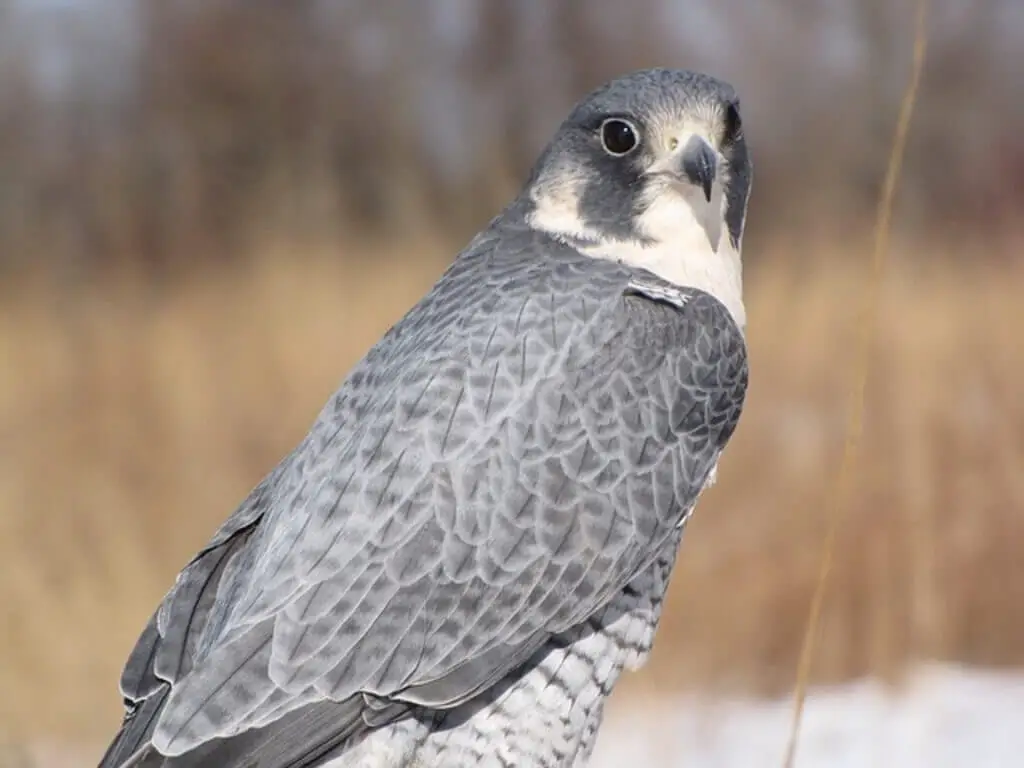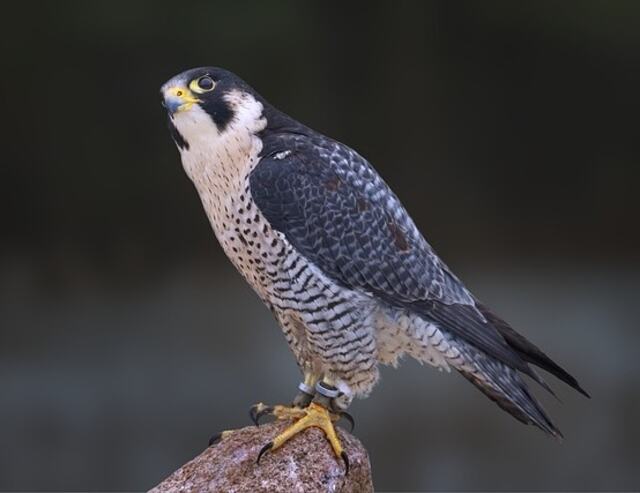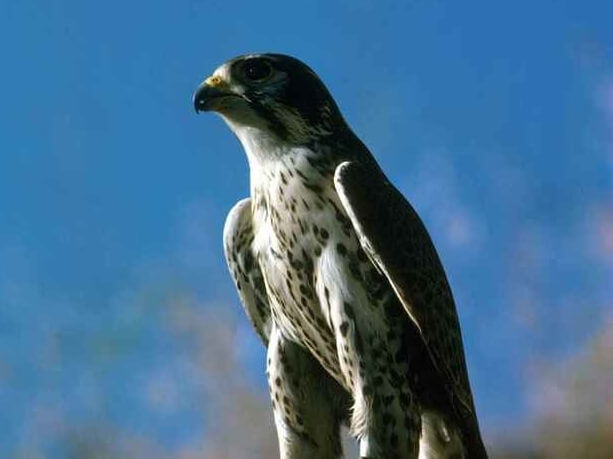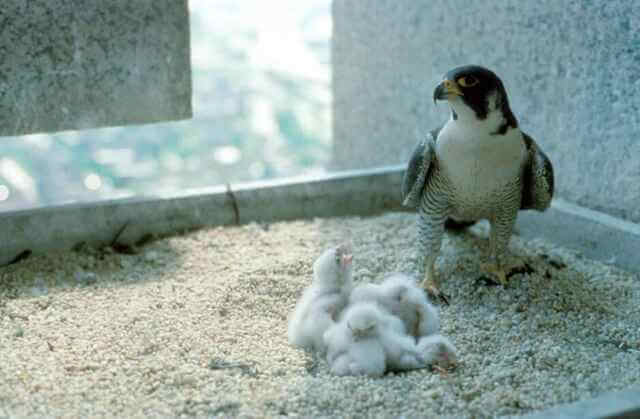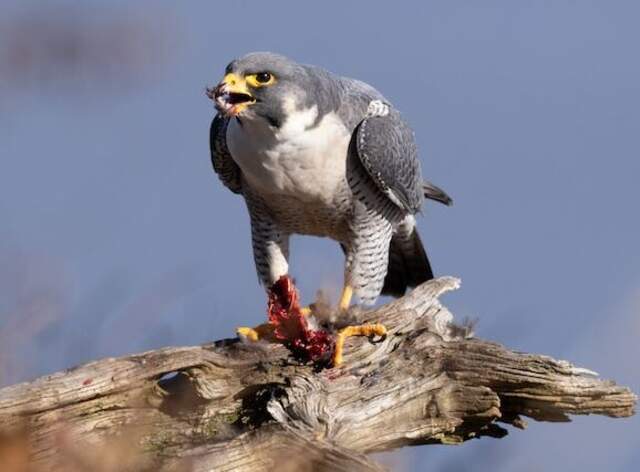Peregrine Falcons, often hailed as awe-inspiring creatures of the natural world, captivate with their remarkable traits and behaviors. In this article, we present a captivating compilation of 40 interesting facts about Peregrine Falcons, complemented by vivid photographs and in-depth details.
Prepare to embark on a journey of discovery, delving deep into the lives of these magnificent birds and uncovering the many facets of their captivating existence.
Table of Contents
- 1 Key Takeaways
- 2 Peregrine Falcon (Overview)
- 2.1 Peregrine Falcons Eat More Than Just Birds.
- 2.2 The name “Peregrine” means “Wanderer” in Latin.
- 2.3 Peregrine Falcons are Everywhere Except Antarctica.
- 2.4 The Black Tear Strip is an Indicator of Gender.
- 2.5 The Female Peregrine Falcon is Larger Than the Male.
- 2.6 When Peregrine Falcons Strike, It’s Fast and Fierce.
- 2.7 Peregrine Falcons Chicks Are Called “Eyasses”.
- 2.8 Peregrine Falcons Exhibit High Intelligence in Hunting
- 2.9 They Are Monogamous and Mate for Life.
- 2.10 Peregrines Can Be Trained to Catch Pests.
- 2.11 Peregrines Are Very Good At Being Stealthy.
- 2.12 Peregrine Falcon Chicks Are Born Altricial.
- 2.13 One Third of All Peregrines Live on Remote Islands.
- 2.14 Peregrines Keep a Sharp Eye on Their Territory.
- 2.15 They rely on Bridges and Skyscrapers for Nesting.
- 2.16 The Spectacular Way Peregrine Falcons Hunt.
- 2.17 The Peregrine Falcon Can See a Mouse From 3 km Away.
- 2.18 They have a Third Eyelid to Protect Their Eyes.
- 2.19 Peregrine Falcons Have a Distinctive “Cackle” Call
- 2.20 Peregrine Falcons Embark on Epic Long-Distance Migrations
- 2.21 Peregrine Falcons Possess Exceptional Long-Distance Vision
- 2.22 Peregrine Falcons’ Role in Falconry: A Centuries-Old Tradition
- 2.23 Impressive Lifespan: Peregrine Falcons Can Live Over 15 Years
- 2.24 Diverse Diet: Peregrine Falcons Are Versatile Predators
- 2.25 Territorial Defenders: Peregrine Falcons Protect Their Hunting Grounds
- 2.26 Symbolic Significance: Peregrine Falcons in Mythology and Culture
- 2.27 Acute Hearing: Peregrine Falcons Use Sound to Locate Prey
- 2.28 Conservation Triumph: Peregrine Falcons’ Recovery From Endangerment
- 2.29 Ingenious Nesting Choices: Peregrine Falcons Prefer Urban Structures
- 2.30 Peregrine Falcons: Masters of High-Speed Hunting
- 3 Author
Key Takeaways
- Peregrine falcons are the fastest birds in the world, reaching speeds of up to 240 miles per hour while diving.
- They are known for their incredible hunting skills, often catching prey mid-air in stunning aerial maneuvers.
- Peregrine falcons were once on the brink of extinction due to pesticides, but conservation efforts have successfully revived their populations.
- These birds have adapted to urban environments, nesting on skyscrapers and bridges in major cities.
- Their striking appearance and exceptional hunting abilities make them a symbol of power and precision in the bird kingdom.
Peregrine Falcon (Overview)
| Identification | Blue-gray back, buff underparts with rusty hue, thin black or dark brown barring, black head, white patches on the neck, dark brown or olive brown wing feathers with lighter edges, grayish under wings with black barring, yellow eye-ring, cere, legs, and feet, long black talons. |
|---|---|
| Size | Length: 13.8-19.7 in (35-49 cm), Weight: 18.7-56.4 oz (530-1600 g), Wingspan: 39.5-43.4 in (100-110 cm) |
| Taxonomy | Order: Falconiformes, Family: Falconidae, Genus: Falco, Scientific Name: Falco peregrinus |
| Range | North America, Europe, Asia, and Africa |
| Habitat | Open country, ocean, coasts, prairies, deserts, grasslands, cities or towns with tall buildings |
| Diet | Carrion, fish, snakes, frogs, mice, insects, seagulls, ducks, pigeons, rabbits |
| Population | 140,000 individuals (Least Concern – Population stable) |
| Nesting Behavior | Nests on cliffs or high places with a wide view, uses rocks and sticks to create an “oven” shape, lined with grasses, mosses, lichens, fur, and small feathers |
| Incubation Length | 29-32 days |
| Nestling Length | 35-42 days |
| Clutch Size | 2-5 eggs |
Peregrine Falcons Eat More Than Just Birds.
They use their speed to catch birds such as seagulls, ducks, pigeons in midair, but they also eat other small animals such as mice, rabbits, squirrels as well as carrion, fish, insects and even snakes.
The name “Peregrine” means “Wanderer” in Latin.
The peregrine falcon is a bird of prey. It got its name from the Latin word “peregrinus” which means “wanderer”. The falcon was named by Pliny the Elder, who wrote about it in his book Natural History.
Peregrine Falcons are Everywhere Except Antarctica.
Peregrine Falcons are one of the most widespread bird species in the world. They can be found on every continent except Antarctica, but nowhere is it more prevalent than North America. There are many factors that contribute to their prevalence, including human activities such as hunting and habitat destruction. These days, however, humans have largely caused them to be extinct outside of areas where they can nest in tall buildings or bridges due to pesticides used by farmers which killed all other food sources for them.
The Black Tear Strip is an Indicator of Gender.
Peregrines have a very noticeable black “tear strip” going from their eyes down to their neck. This strip allows you to differentiate male and female falcons, since the female’s strip is usually gray.
The Female Peregrine Falcon is Larger Than the Male.
The female Peregrine Falcon is larger than the male. The average weight of a female Peregrine Falcon is 1,200 grams and an average height of 46-55 centimeters (4 inches taller and 300-400 grams heavier). This size difference between males and females may be due to how much energy it takes for a female to produce eggs.
When Peregrine Falcons Strike, It’s Fast and Fierce.
Peregrine falcons are known to be fierce hunters, even though they are extremely fast. They catch their prey by diving at it from a very high altitude, grabbing it with their talons and carried it back to the nest.
Peregrine Falcons Chicks Are Called “Eyasses”.
The Peregrine Falcons chicks are called “Eyasses”. They grow quickly at an average rate of about 1 inch every week until they’re fledged, which means their feathers will come out, and will leave the nest.
Peregrine Falcons Exhibit High Intelligence in Hunting
Peregrine Falcons are not only swift and agile but also highly intelligent hunters. They demonstrate exceptional problem-solving skills when stalking and capturing prey. These birds analyze the flight patterns and behavior of their targets, adapting their hunting strategies accordingly. Their combination of speed and intelligence makes them formidable predators in the avian world.
They Are Monogamous and Mate for Life.
Peregrine Falcons mate for life. They are monogamous and form strong bonds that last a lifetime. Peregrines typically mate for life, but there have been cases where one partner was killed or disappeared.
Peregrines Can Be Trained to Catch Pests.
The Peregrine Falcon is a bird of prey, the fastest creature on earth. However, they are also known for their prowess as a hunter and can be trained to catch pests that might damage crops (such as the Norway rat.) However, training them requires a lot of patience and effort on the trainer’s part!
Peregrines Are Very Good At Being Stealthy.
Peregrines are known for their speed and agility, but what many people don’t know is that they can also be quite stealthy. The Peregrine Falcon is able to fold its wings into its back, allowing it to compress into the size of a pigeon. This allows them to stay undetected perched on power lines and other structures.
Peregrine Falcon Chicks Are Born Altricial.
The Peregrine falcon chicks are altricial, meaning they are born “wet”, naked, blind and helpless, eventually gaining their eyesight after about one week of age. The fledglings will leave the nest about a month later, or once they can hunt, and become dependent on their own.
One Third of All Peregrines Live on Remote Islands.
Peregrines are a type of falcon that can be found in many places around the world. One third of all Peregrines live on remote islands such as Gough Island off the coast of Africa or cliffs near oceans like those found on Baja California’s Guadalupe Island. They have been seen at sea level, up to 4000 feet above sea level and even in caves.
Peregrines Keep a Sharp Eye on Their Territory.
When not hunting, peregrines will stay on their territory all day long. They typically spend most of the time perched in a tree, looking out for any intruders that might disturb them or their nest site below.
They rely on Bridges and Skyscrapers for Nesting.
These birds nest on cliffs or other high structures near large cities, such as bridges and skyscrapers, because these areas provide them with good vantage points for hunting birds below them.
The Spectacular Way Peregrine Falcons Hunt.
Peregrine Falcons are one of the most impressive hunters in the animal kingdom. These birds have one of the most impressive flight patterns, called a stoop, where they dive at high speed towards their prey and then pull out just before hitting it. This hunting technique is also known as a pounce or plummeting attack. Peregrines will go after almost any bird, but their favorite prey includes ducks, geese, pigeons and shorebirds.
The Peregrine Falcon Can See a Mouse From 3 km Away.
The Peregrine Falcon has an impressive eyesight. This falcon’s vision is eight times better than that of humans; it can see prey at distances up to 3 km (1.86 miles) away! This means that the falcon has no problem seeing its target before it dives in.
They have a Third Eyelid to Protect Their Eyes.
Peregrine Falcons have a third eyelid that they use to protect their eyes while diving. This is called the nictitating membrane, and it acts as a protective barrier for the eye. The nictitating membrane is translucent, so it does not interfere with vision during dives, but still helps keep the eye moist by spreading tears across its surface.
Certainly, here’s the format you can use for the additional facts about Peregrine Falcons:
Peregrine Falcons Have a Distinctive “Cackle” Call
Peregrine Falcons are known for their unique and unmistakable “cackle” or “kak-kak-kak” call. This vocalization serves various purposes, including communication with other falcons and establishing territory. It’s a sound that bird enthusiasts and ornithologists often associate with these remarkable birds of prey.
Peregrine Falcons Embark on Epic Long-Distance Migrations
One of the remarkable aspects of Peregrine Falcons is their ability to undertake extensive long-distance migrations. These birds travel over 20,000 miles during their seasonal journeys, navigating across continents and diverse landscapes. Their migratory behavior is a testament to their resilience and adaptability in different environments.
Peregrine Falcons Possess Exceptional Long-Distance Vision
Peregrine Falcons are renowned for their extraordinary vision, allowing them to spot distant objects with incredible precision. This keen eyesight plays a crucial role in their hunting success, enabling them to lock onto prey from great distances. Their specialized eye anatomy is a marvel of nature’s design.
Peregrine Falcons’ Role in Falconry: A Centuries-Old Tradition
For centuries, Peregrine Falcons have been integral to the practice of falconry, a traditional hunting method that involves trained birds of prey. These magnificent birds have served as skilled hunting companions, assisting humans in capturing game such as waterfowl and small mammals. Falconry enthusiasts continue to admire and work with Peregrine Falcons to this day.
Impressive Lifespan: Peregrine Falcons Can Live Over 15 Years
In the wild, Peregrine Falcons have the potential to live for more than 15 years, demonstrating their ability to thrive and adapt in various environments. In captivity, they have been known to exceed this lifespan, with some individuals reaching up to 20 years. Their longevity is a testament to their resilience and survival instincts.
Diverse Diet: Peregrine Falcons Are Versatile Predators
Peregrine Falcons are not limited to a single type of prey. While they are renowned for catching birds in midair, their diet extends to include small mammals like mice, rabbits, and squirrels, as well as carrion, fish, insects, and even snakes. This versatility in their diet showcases their adaptability as apex predators.
Territorial Defenders: Peregrine Falcons Protect Their Hunting Grounds
Peregrine Falcons are known for their strong territorial instincts. They vigorously defend their hunting territories, which can encompass a range of habitats. Their territorial behavior ensures a consistent supply of prey and a safe environment for raising their young.
Symbolic Significance: Peregrine Falcons in Mythology and Culture
Across various cultures and mythologies, Peregrine Falcons hold symbolic significance. They are often seen as symbols of power, speed, nobility, and even divine intervention. These birds have left their mark on human history and continue to inspire awe and reverence.
Acute Hearing: Peregrine Falcons Use Sound to Locate Prey
In addition to their remarkable vision, Peregrine Falcons also possess acute hearing. This auditory prowess aids them in locating prey, even when it’s out of sight. Their ability to use sound to pinpoint potential meals further enhances their hunting success.
Conservation Triumph: Peregrine Falcons’ Recovery From Endangerment
Peregrine Falcons have experienced remarkable conservation success stories, bouncing back from the brink of endangerment in many regions. These tales of recovery underscore the positive impact of human intervention and efforts to preserve and protect these majestic birds of prey.
Ingenious Nesting Choices: Peregrine Falcons Prefer Urban Structures
Peregrine Falcons have adapted surprisingly well to urban environments. Instead of traditional nesting sites in cliffs, they often choose man-made structures like skyscrapers, bridges, and tall buildings for their nests. This adaptation to urban life has contributed to their continued survival in densely populated areas.
Peregrine Falcons: Masters of High-Speed Hunting
Peregrine Falcons are renowned for their spectacular hunting techniques. When they strike, it’s a display of speed and precision. They execute steep, high-speed dives called “stoops” to surprise their prey. During these stoops, they can reach speeds of up to 240 miles per hour, making them the fastest animals on Earth. This exceptional hunting ability sets them apart as apex predators in the avian world.

